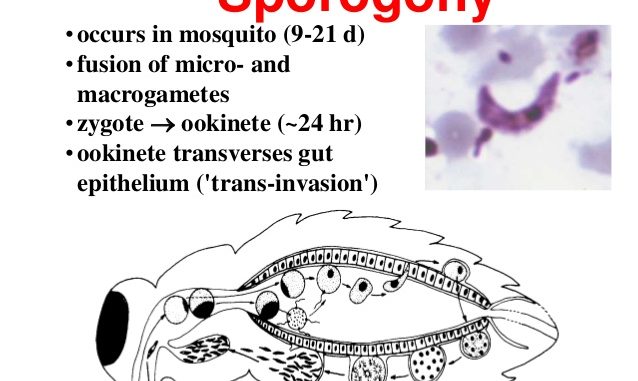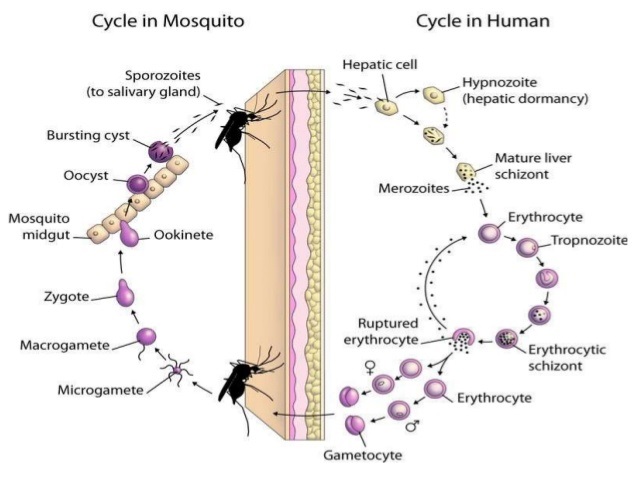
- This cycle occurs inside the mosquito’s body which begins with the ingestion of gametocytes by the female Anopheles during the blood meal.
- The gametocytes released from the erythrocytic life cycle in man require low temperature, for their further development and hence transmission to another host becomes a necessity.
- All the phases of the sexual cycle complete outside the cells, hence also known as exogenous phase.
- In this process, schizogony changes into gametogony and the formation of gametes takes place.
- The gametocytes reach in the alimentary canal of the mosquito along with the host blood meal.
- These are set free due to the rupture of the RBCs by the action of digestive enzymes in mosquito’s gut and then produce gametes.
- The gametocytes are of two types:
- Micro-gametocytes
- Macro-gametocytes
- Micro-gametocytes:
- These are smaller in size and less numerous in number.
- The size ranges from 9µm-10µm.
- The nucleus is laterally placed and the cytoplasm is clear without any inclusion bodies.
- The liberated microgametocytes become very active.
- The nucleus divides into 6 to 8 haploid nuclei and they are seen in the periphery surrounded by the developing axoneme.
- It then changes into an amoeboid stage which undergoes exflagellation.
- Exflagellation is associated with the formation of male gametes (microgametes).
- The microgametes are sperm like cells, flagellated and highly motile each having a single flagellum.
- In the stomach of mosquito, an increase in the pH caused by the escape of CO2 from the blood is suggested to be the stimulus for the process of exflagellation.
- Macro-gametocytes:
- They are larger in size and are numerous.
- The size ranges from 11 µm-12 µ
- The nucleus is placed peripherally and compact.
- The macro-gametes (female gametes) show fewer changes in its formation.
- It divides by meiosis and one or two small fragments become separated. These are seen in the periphery and are known as polar bodies.
- The female gametes now prepare for fertilization.
Fertilization:
- A small projection arises from the posterior part of the macro-gamete which is known as fertilization cone.
- The matured micro-gametes are attracted to this part and meet or fuse together.
- After the fusion of the gametes, a zygote is produced which is also known as a synkaryon.
- The zygote of Plasmodium is motile.
Ookinete:
- The zygote remains rounded and inactive for some time and later becomes long, vermiform and motile structure called ookinete.
- The tapered end of ookinete helps it to pierce the gut wall of the mosquito.
- The ookinete forms a cyst around it and changes into an oocyst.
Oocyst:
- The encysted zygote is known as oocyst.
- The oocyst of Plasmodium is thin, membranous and elastic.
- The cystic layer is partly secreted by the stomach wall of the mosquito and partly by the ookinete.
- The oocyst is diploid in nature and multiplies asexually. It divides by meiosis and later produces enormous number of daughter nuclei mitotically which are surrounded by some parts of protoplasm known as sporooites.
- After 10 days of development in the stomach wall (after the bite), the sporozoites come to the alimentary canal from the gut wall and then reside in the salivary glands.
- When this female Anopheles mosquito bites a healthy person, the sporozoites are released in his blood along with saliva.
- In man, the sporozoites then undergo schizogony (asexual cycle).
